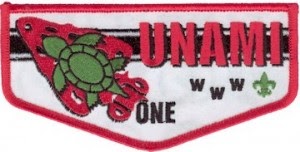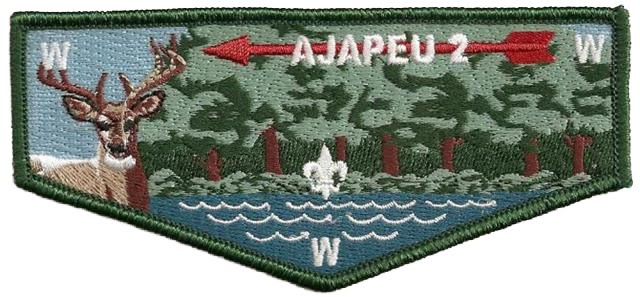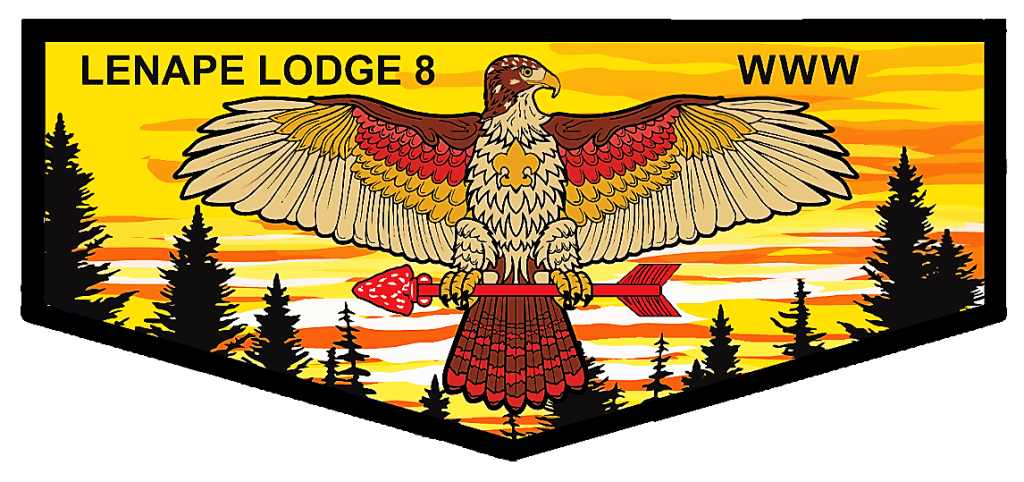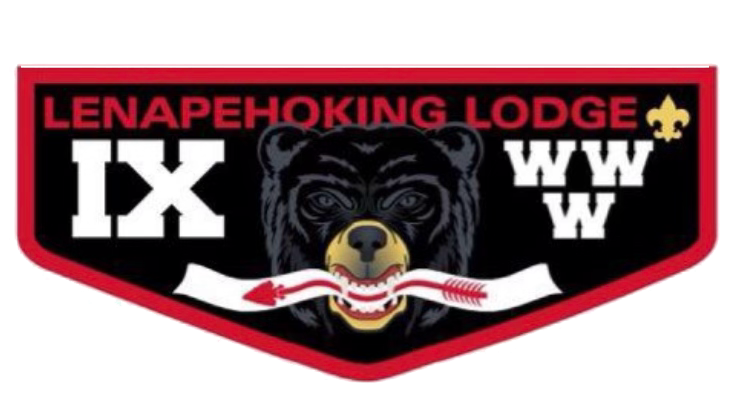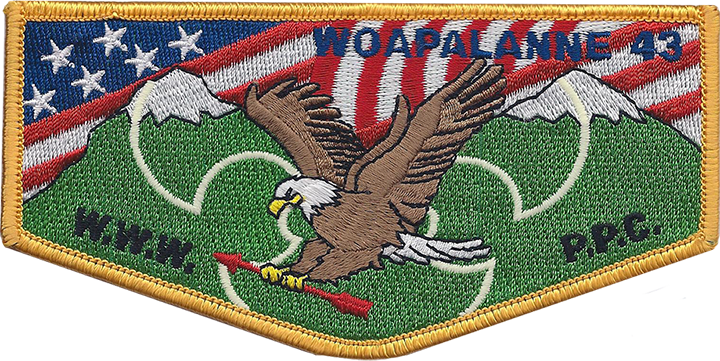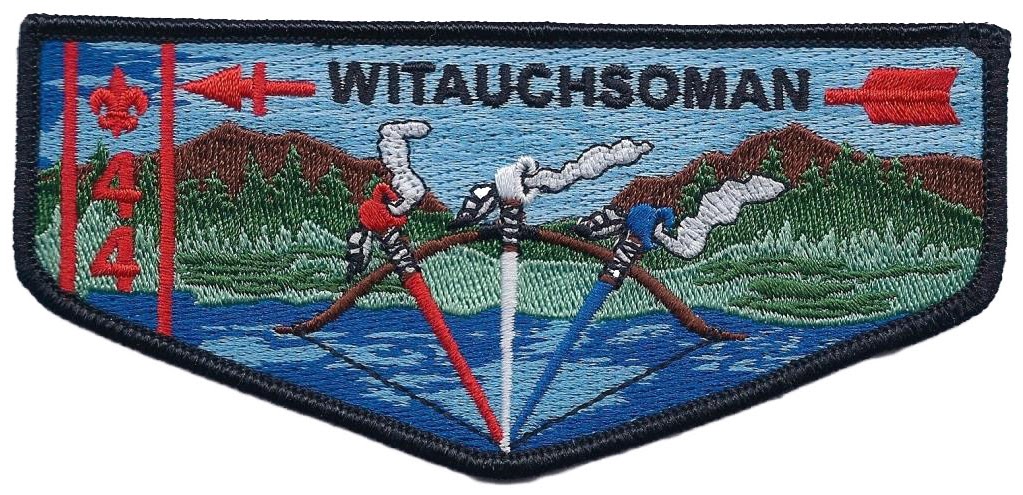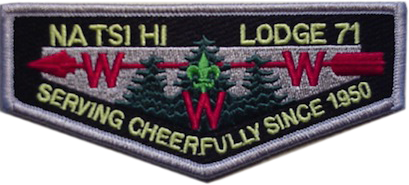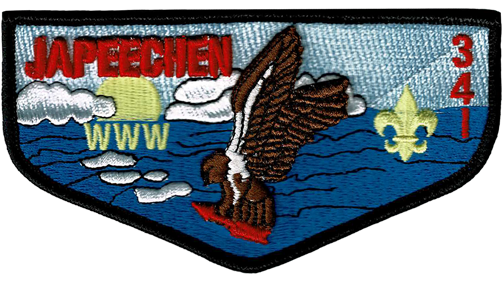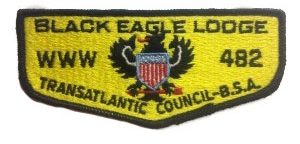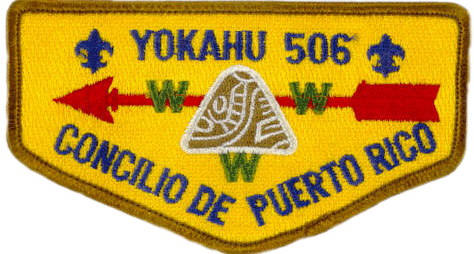Unami Lodge, and the Order, was founded at Treasure Island Camp in the summer of 1915 by E. Urner Goodman, the camp director, and Carroll A. Edson, the assistant camp director in charge of the commissary, to perpetuate camp traditions and ideals from summer to summer. The organization was to be based on Lenni Lenape traditions.
At Treasure Island, a natural ravine near the south tip of the island was selected as the new Order’s ceremonial ground. Preparatory work in getting this site ready for use was done by Goodman and Harry Yoder of Philadelphia Troop 3. Yoder is soon appointed as the Order’s first guide and guardian. A totem decorated with a tortoise was erected at the ceremonial ground. This totem was chosen because it was used by Chingachgook and Uncas (familiar from James Fenimore Cooper’s Leatherstocking Tale and our own Legend). The tortoise is also the symbol of one of the three major Delaware clans (along with the Turkey and Wolf).
The original ceremonial robes were made by a local farmer’s wife, and after dark on July 16, 1915 the first ceremony is performed. Two scouts (Robert Craig and Gilpin Allen) were led silently by Guide Yoder in single file from the flag pole at the parade grounds to the ceremonial grounds and a three step open ritual began before the assembled camp. Each of the three parts of the ritual represented a different ideal of a new society called Wimachtendienk W.W.: Brotherhood, Cheerfulness, and Service. The first Ordeal is spent performing service for the local farmers on the mainland in silence and without food. At the end of the first summer 25 members (including Goodman and Edson) were wearing the black sashes with white bars signifying membership in the Wimachtendienk.
During the first year Dr. William Hinkle planned the ritual for a second degree, later to be called the Brotherhood. This gives rise to the third degree, later to be called the Vigil Honor. The first Vigil Honor goes to E. Urner Goodman, followed that winter by Carroll Edson. Returning from the Devil’s Tea Table where his Vigil was kept, Goodman receives only his Indian name, Nuwingi (interpreted as “the Willing”), as the triangle representing the Vigil Honor was not yet used.
Later that first year the arrow and turtle are formally adopted as symbols of the lodge. George Chapman is elected as the first lodge chief.
The Unami Lodge house on Treasure Island is begun in 1919 and completed in 1921 with funds and labor supplied by the lodge. A dining addition is added in 1937 and a sleeping addition and bathroom are added in the 1980s. The original structure is much the same today as in was in the 1920s.
Today, Unami Lodge, One serves the great scout camps of the Cradle of Liberty Council: Treasure Island (founded 1913, closed 2008), Resica Falls (founded 1956), and the three camps of Musser Scout Reservation, Camp Delmont (founded 1916), Camp Hart (founded 1930) and Camp Garrison (opened in 1999).
In 1928, because of the cheerful service exhibited by a group of Scouts during summer camp at Buccou Camps, Scout Executive William F. (“Uncle Bill”) Livermore arranged to have the Degree Team from the George Washington Council, of Trenton, N.J., initiate into the “Ordeal Honor,” these boys who had unselfishly served their fellow campers.
Each year approximately fifty new members were received into the Ordeal Honor. Incentive in Lodge activities was so great that the demand grew for advancement, thus bringing about the birth of our first Brotherhood Honor members. The first Vigil Honor brother was Scout Executive “Uncle Bill” Livermore.
During the 1937 summer camp season, Sakima “Bill” Carlin, visited Buccou each Sunday evening to give the “Legend of the Delawares” to the Scouts and Scouters assembled at “Inspiration Point”. It was at this Ceremony that boys and men received their inspirations and developed incentive to become something worthwhile to Scouting.
At the final Ceremonial Campfire of the 1938 summer camp season, the Lodge presented to the retiring Scout Executive, “Uncle Bill” Livermore, as a token of their esteem and in appreciation of the things he did and what he meant to the members in the Lodge; a beautiful Scout statuette, appropriately engraved, which is a representation of Ajapeu Lodge.
In 1939, the last year of Camp Buccou, the OA published a comprehensive booklet containing a general overview of the organization.
On January 1, 2013, Burlington County Council and Southern New Jersey Council merged to form a new Boy Scout council to serve the youth in South Jersey – the new Garden State Council, BSA.
Each former council had an Order of the Arrow Lodge:
- Burlington County Council – Hunnikick Lodge #76
- Southern New Jersey Council – Te’kening Lodge #37
On January 1, 2014, the two current lodges merged and became Lenape Lodge #8. The lodge name is translated as “The Original People” and the lodge totem is the red-tailed hawk.
Both lodges have a long-standing, historical ties to the Order of the Arrow in South Jersey. Dating as far back as 1935, Hunnikick Lodge was established as the Order’s 76th lodge, and soon after, Lekau Lodge – a predecessor to Te’kening – as the Order’s 77th lodge. As Hunnikick and Te’kening come together to create a new lodge, we will carry forward the traditions and history of those who have served before us in both Hunnikick and Te’kening. And, to that end, we will move forward in service to others with as much passion as our founders, strengthening our past and building our future together.
Lenapehoking Lodge IX is the Order of the Arrow Lodge of Northern New Jersey Council. The totem is the Spirit of the Lenape, and the translation of the name is “Home of the Lenape.” IX was formed in 1999 upon the merger of Mantowagan 14 (Hudson Liberty), Meechgalane 178 (Essex), Oratam 286 (Bergen), and Aquaninoncke 359 (Passaic Valley). Although four lodges made up Lenapehoking Lodge IX, its foundation goes back all the way to 1921 with Pamrapaugh 14, the ninth lodge organized that met at the Grand Lodge Organization meeting on October 7, 1921. However, a clerical error showed the number 9 given to Cowaw and Pamrapaugh settled on the number 14. In 1916, Jersey City Council was the first council chartered by the US Congress, and has roots within this council. Also, founder Carroll Edson formed Achtu 37 when he became Scout Executive of Hudson Council and sat his vigil in this lodge. Seventeen different lodges make up what is now Lenapehoking IX.
In the year 1999, the Boy Scouts of America, in an effort to help a number of councils reorganize, oversaw a number of council merges. During the year 2000, the Morris-Sussex Area Council (based in Denville, NJ) and the Watchung Area Council (based in Mountainside, NJ) underwent such a merger. The two merged councils formed the Patriots’ Path Council – now based out of Florham Park, NJ. As a result, during the year 2000, there were merger meetings between the two lodges (Allemakewink #54 and Miquin #68). The name decided on was “Woapalanne #43”, roughly translating to “eagle”. The merger committee decided that the lodge color would be green, and that the totem would be an eagle with outlined feathers. In the spring of 2001, the lodge held its first Fellowship Day. Also, Peter Keays, the Lodge’s first chief, was elected to be NE-2B Section Chief in that same year. In 2002, Woapalanne participated in its first NOAC at Indiana University. Woapalanne was one of only two lodges in the Northeast Region and one of only eight in the country to earn the E. Urner Goodman Camping Award. In 2003, Woapalanne held its first ever section conclave for Section NE-2B at Mt. Allamuchy Scout Reservation. The year 2006 was a big year for the lodge. On January 1, 2006, the lodge celebrated its 5th Anniversary in existence. At the NE-2B Section Conclave, our immediate Past Lodge Chief, Joe Maugeri, was voted in as the Section Vice Chief, the second lodge member to hold a section position. In the summer of 2006, a Woapalanne contingent traveled to NOAC, this time going to Michigan State University for NOAC 2006. In 2007, Joe Maugeri was elected Section Chief and Casey O’Connor was elected Section Secretary for NE-2B!. In 2008 Past Lodge Chief, Bob DeMaria was elected Section Vice Chief and lodge chief, John-Paul Couce was elected Section Secretary . His predecessor would be Frank Caccavale who held office from 2009-2012 for both NE-7A and NE-5A. Woapalanne attended the next NOAC in 2009 and also attained the status of Quailty Lodge. Woapalanne sent many brothers to the 2010 National Scout Jamboree at Fort AP Hill to celebrate the 100th Anniverary of Scouting. In 2011, Bill San Filippo was elected Section Chief of NE-5A and the lodge also earned the status of Quality Lodge.
In 1928, there emerged one of the three ancestors of Witauchsoman Lodge, Pohopoco Lodge 44. The Lodge served the Lehigh Council that operated Camp Trexler. For 41 years the Pohopoco Lodge acted as a pilot lodge, helping to start new lodges in the area.A few years later in 1931 the Kittatiny Lodge 58 was chartered to the Delaware Valley Council and its Camp Weygadt. In 1948 the lodge was re-chartered and changed its name to Ah’Pace. The Bethlehem Area Council chartered its own lodge in 1952, the Tunkhannock Lodge 476. Those Arrowmen served Camp Minsi.In January 1969, these lodges came together, forming the first tri-merger in the history of the Order of the Arrow. The name selected for the new lodge was Witauchsoman, which means “to be in fellowship with somebody”. They took the number 44 for the lodge. The totem of the lodge is three peace pipes (symbolizing the three predecessorlodges) strung on a bow. The lodge has become a strong and vibrant force in the Minsi Trails Council.
In 2009 the Witauchsoman Lodge along with the Minsi Trails Council celebrated forty years of service to the Scouting program. The year 2012 brought Witauchsoman lodge two accolades from National. First we were recognized for the delivery of our annual reports, highlighting our video presentations and the content of the reports. Soon afterwards we received a call that the Lodge had received the National Service Award.
In the late 1940s, Monmouth Council troops attended other council’s summer camps where they saw Order of the Arrow lodges in operation, and a spark of interest was rekindled. A small group of youth and adults gathered in December 1950 in the Pine Hollow cabin at Camp Housman on the old Allaire property just one mile from where the original Ohowa lodge 71 had been founded. The Scouts had already been inducted into the Order at other council’s camps. They formed a new lodge called Na-Tsi-Hi, which meant “in the pines”-a reference to Camp Housman’s location on the northern fringe of the Pine Barrens. The lodge’s totem would be “three pine trees” to represent the three parts of the Scout Oath and the three principles of the Order. Robert Schwab was chosen as the first Chief of Na Tsi Hi. Among the adults present at that first meeting was J. Townley Carr, who was Scoutmaster of Long Branch Troop 39 and who served as the first lodge adviser. The new lodge was approved by the council’s executive board and received its national charter (re-using the old number 71) in early 1951.
As the nation prepared for the Bicentennial, councils were encouraged to develop historic trails so that Scouts would learn American history while developing their Scouting skills. The arrowmen of Na Tsi Hi created the Battle of Monmouth Historic Trail, formally dedicated on April 12, 1975. The Trail begins at Quail Hill Scout Reservation in Manalapan, travels through the historic countryside and the Monmouth Battlefield State Park, and ends at the battle monument in colonial Freehold.
In 1982 the lodge inaugurated the council’s first Webelos Woods campout. In 1987 the lodge administered its Ordeal induction under the Elangomat system for the first time.
Since its institution, Na Tsi Hi has been recognized with the National Service Award in 2007, and the E. Urner Goodman Camping Award in 2000 and 2009. The Arrowmen of Na Tsi Hi will continue to rise to the greater challenge and carry on the tradition of Brotherhood and Cheerful Service.
Lowwapaneu Lodge 191 was first chartered in January of 1991 after the 1990 consolidation of the Penn Mountains Council (Wilkes-Barre) and Forest Lakes Council (Scranton). With the consolidation of both councils their Order of the Arrow lodges would also merge. In 1990 members of both Acahela Lodge 223 (Wilkes-Barre) and Amad’ahi Lodge 542 (Scranton) met together to formulate the name and bylaws for a new Order of the Arrow Lodge. The new lodge name “Lowwapaneu,” was appropriately selected and contains the Lenape words for north and east. They represent the new Northeastern Pennsylvania Council that was formed. The original totem of Lowwapaneu Lodge 191 was a totem pole that depicted the totems of previous Order of the Arrow Lodges of Northeastern Pennsylvania. In 1996, the totem was changed to a fire and a four-colored circle of life.
Since 1991, Lowwapaneu Lodge has been active in serving the Northeastern Pennsylvania Council in various service projects. In 2002, Lowwapaneu Lodge was awarded the National Order of the Arrow Service Grant for its service project “The Order of the Arrow Teaches Citizenship.” The following year 2003, Lowwapaneu Lodge received the prestigious Order of the Arrow National Service Award for its service in both a quantitative and qualitative sense to the Northeastern Pennsylvania Council. The award was presented to our Lodge at the National Meeting of the Boy Scouts of America in May 2003. Only two lodges from each region receive the award annually. Lowwapaneu Lodge is the home of 2 past national officers: 2013 National Vice-Chief Jordan Hughes and 2015 National Vice-Chief Donnie Stephens.
In 2016, Lowwapaneu Lodge celebrated its 25th anniversary with the theme “Nosawoapamen Wapahamink” which is interpreted as “To look back”.
Japeechen Lodge 341 of the Order of the Arrow was first chartered to the newly formed Jersey Shore Council, Boy Scouts of America, on January 1, 1993. To search out the history of this infant lodge, young braves must first look at two great past lodges, Gitche Gumee # 423 and Schiwa’ Pew Names # 535.
Gitche Gumee was chartered on September 23, 1949, as the Order of the Arrow Lodge affiliated with the Atlantic Area Council # 331. The name of the lodge was taken by its founders from the Indian term for “the great waters” in Henry Wadsworth Longfellow’s “SONG OF HIAWATHA”. The Laughing Gull, symbolizing the coastal environment that largely encompasses the Atlantic City region, was chosen as the lodge totem.
The first Vigil recognition was held in the Lodge ceremonial grounds in 1954 when Brother Raymond Wright was conferred the honor. Wright was also the first Adviser, holding the post from 1949 to 1959. He was succeeded by the late S. Edward Bickerstaff and Dave Lutton. The first Chief was Peter Buck, who served from 1949 to 1951. In 1974, Gitche Gumee celebrated its 25th Anniversary. In 1993, the lodge merged with neighboring lodge, Schiwa’ Pew Names.
As a “newer” lodge to the Section, Schiwa’ Pew Names hosted 2 local Order of the Arrow gatherings. It hosted the 1982 and 1992 NE-4B Conclaves. In 1992, Schiwa’ Pew Names celebrated its 35th anniversary by hosting the NE-4B Section conclave. This was the last conclave the lodge would host, as Ocean County Council #341 and Atlantic Area Council #331 would merge to form the Jersey Shore Council #341, later that year.
The new lodge, Japeechen, would also receive the number 341. Given the many scenic rivers that flow through the new council, the youth members of the infant lodge chose “Japeechen” as their name. Translated from Lenni-Lenape, the name means “along the bank.” An Osprey (commonly referred to as a “sea eagle”), arrow in Claws and flying over the Atlantic Ocean with rising sun in the background was chosen as their symbol. Matthew Simmons was elected as the first Chief, while Richard Dempsey served as the first Adviser.
Black Eagle Lodge was first chartered on September 23, 1952. Initially, the lodge did not have a name or totem. In the fall of 1952, the lodge founder, Mr. Walter Buote, and other OA members in the Heidelberg area conducted elections in troops as far away as Giessen, West Germany. That same fall, the first lodge Ordeal, Fellowship, and Training Conference was held in the Tompkins Woods Training area.
In the spring of 1953, another combined Ordeal and Lodge Fellowship and Training Conference was held in central West Germany. At the event, the first lodge chief, Hudson B. Phillips, Jr., was elected and the lodge totem and name were selected.
In 1955, the lodge formed chapters to coincide with the districts of the Transatlantic Council. The initial lodge area served the civilian and military families on duty in Germany and Austria. By 1959, the service area was expanded to include other military facilities in Europe, the Near East, and in North Africa. Today, Black Eagle Lodge serves more land area than any other lodge in the Order.
Yokahú Lodge was founded in 1954, after a group of local Scouts witnessed an OA indian dance at the 1953 National Jamboree. Luis Matías Ferrer, a legendary local scouter, persuaded the Council Advancement Commitee to approve the adoption of the Order of the Arrow in Puerto Rico. Letters were sent to Scoutmasters asking to select one Scout per troop to attend the first Ordeal, held at Camp Guajataka. The first Ordeal Master was Dr. Frank H. Wadsworth, the only OA member in the island, being inducted as a youth in the United States. Soon after the lodge established a constitution and service program to benefit the local council. The first Brotherhood Ceremony was held at the Río Piedras Agricultural Experimental Station in 1955 and the first Vigil Honor was conferred to four Arrowmen at Camp Guajataka in 1957. Yokahu Lodge totem is the Cemí, a crop and fertility deity represented in a three point stone idol. Yokahu Lodge name is derived from “Yukahú Bagua Maraocotí- Lord of Cassava With No Beginning Or End” the main god in Taíno indian religion. The lodge has eight chapters who perform cheerful service to Scouting, Camp Guajataka and local communities.

